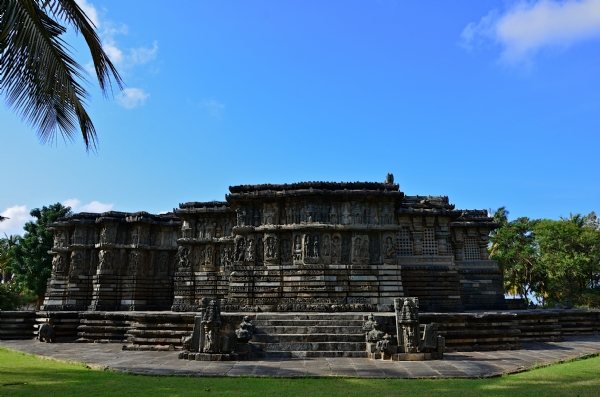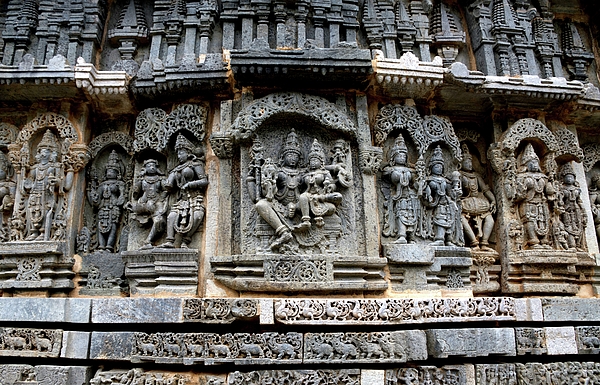Kedareshwara Temple, the 12th century masterpiece of Hoysala empire
Scores of devotees visit here every year to witness the wonder that is this temple; built in the 1219 AD, it is dedicated to Lord Shiva.
Total Views |
Halebidu has to offer some of the most special temples in our country, and today we will explore one of those, whose architecture, is no doubt incomparable to any other structure. Located in the Hassan District of Karnataka State, the Kedareshwara Temple is near the famous Hoysaleswara temple in Halebidu. The architecture and the interior of the temple is impressive.

The interior also has a porch connecting the central hall to the platform. The deity of worship is missing from the sanctums. But you will find the temple on a platform called the Jahati which is 5 to 6 ft tall, small steps are used to reach to the top.
The four star-shaped pillars on either side of the entrance which are the usual masterpiece of Hoysala art welcomes all devotees. The entire temple is beautifully studded with the images of Lords Shiva, Vishnu, Brahma, Lakshmi, Saraswathi, Krishna, Varaha, Ganesh, etc. Each are holding their own weapons in different postures.

The level of imagination and execution that went into carving these, proves that the Hoysalas had mastered the art of 3 Dimensions and had understood their geometry well. The temple complex is protected under the Archaeological Survey of India, which requires importance among the tourists visiting Hoysaleshwara temple of Halebidu, as it looks pretty deserted a lot of the times.

Countless devotees visit here every year to witness the wonder that is this temple. The temple was supposedly built in 1219 AD & is dedicated to one of the most prominent Hindu Gods - Lord Shiva. The brilliant architecture of this ornate Temple is protected as national importance by the Archeological Survey of India. Here are some facts about the temple that you might want to know before visiting:
History | The Kedareshwara temple in Halebidu was constructed by Hoysala King Veera Ballala II (1173–1220 A.D.) and his Queen Ketaladevi. Historians speak highly of this temple as there were only a few other structures in India, which would have conveyed a better idea of what their architecture was capable of doing.
Architecture | The architecture of Kedareshwara Temple in Halebidu is a brilliant example of the Hoysala style of structure of the olden days. Some main additions inside the temple are the Vimana and Mahamandapa which enhance the interior of the temple’s architecture. The main shrine is outlined in a star shape with two smaller shrines. The temple has three shrines in total and the sanctums are connected to a central hall.
The interior also has a porch connecting the central hall to the platform. The deity of worship is missing from the sanctums. But you will find the temple on a platform called the Jahati which is 5 to 6 ft tall, small steps are used to reach to the top.
Also Read | Airavatesvara Temple, the intricate UNESCO heritage of Tamil Nadu
The outlay of main shrine (Vimana) is star-shaped (stellate) with 2 smaller shrines that have perforated windows on sides. Despite being a Shaiva temple (of Lord Shiva), it is well known for its friezes and the panel relief that depict depictions from both Shaiva and Vaishnava (of Lord Vishnu) legends. The temple has 9 levels of friezes from the basement. Above the friezes, you will find as many as 200 different sculptures of the various godly forms and mythological stories.
The four star-shaped pillars on either side of the entrance which are the usual masterpiece of Hoysala art welcomes all devotees. The entire temple is beautifully studded with the images of Lords Shiva, Vishnu, Brahma, Lakshmi, Saraswathi, Krishna, Varaha, Ganesh, etc. Each are holding their own weapons in different postures.

The ceilings here, and the spiked pillars inside this temple are the most beautiful parts get a feel of. The sculptures in the corners of the walls share the limbs with each other on either of the side.
The level of imagination and execution that went into carving these, proves that the Hoysalas had mastered the art of 3 Dimensions and had understood their geometry well. The temple complex is protected under the Archaeological Survey of India, which requires importance among the tourists visiting Hoysaleshwara temple of Halebidu, as it looks pretty deserted a lot of the times.


